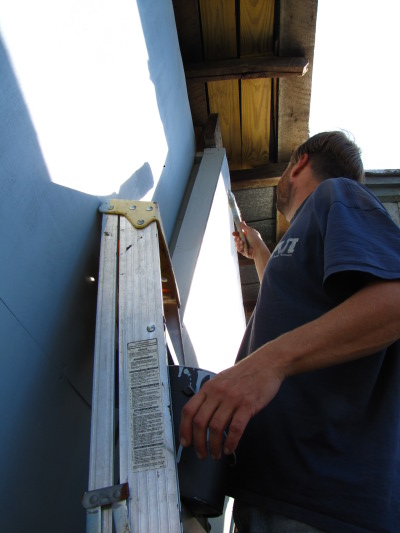
Unwanted colors

It has taken me a long time to wise up to the fact that you usually get
what you pay for when it comes to paint products.
A lesser grade paint may have
needed a 2nd or even a 3rd coat to look good, but this Kilz stuff has what it takes to
cover a wall right the first time.
We got lucky and found a few
cans of this high quality paint discounted where someone had ordered a
mixed color and wasn't quite happy with it.
Want more in-depth information? Browse through our books.
Or explore more posts by date or by subject.
About us: Anna Hess and Mark Hamilton spent over a decade living self-sufficiently in the mountains of Virginia before moving north to start over from scratch in the foothills of Ohio. They've experimented with permaculture, no-till gardening, trailersteading, home-based microbusinesses and much more, writing about their adventures in both blogs and books.
Want to be notified when new comments are posted on this page? Click on the RSS button after you add a comment to subscribe to the comment feed, or simply check the box beside "email replies to me" while writing your comment.

You can pick two out of three.
Daddy --- the label says "Primer---Sealer---Stainblocker". We asked the guy in the paint section when we bought it and he said it is a good exterior paint. Since sealing is really what we want it for, I'd say it would work based on the label.
Roland --- I guess this is good and cheap, with the slow part being that we had to check a few stores before we found the right mismatched paint.
Primer has many possible functions depending on the material it is to be applied on. But basically it's function is indeed to improve adhesion of the paint to the substrate. Therefore the composition of primer can and will differ from that of paint.
On many metals and plastics primers or other treatments are often necessary to get any adhesion. Aluminium is typically primed before painting or bonding. There are primers for iron that convert rust into a passivated layer. On wood one of the functions is to fill voids.
So always use a primer that is meant for the substrate it is used on. Usually it is OK to leave a wood primer unpainted for a couple of weeks; it is not always possible to paint it immediately. But it will not have the protective abilities as paint.
For future reference, there are several kinds of wood that weather well and don't need paint. Red Cedar to name one. There are also new types of (non-toxic) modified wood like aquawood that do not absorb water anymore.
Natural and renewable alternatives for oil-based paints are linseed oil and tung oil.
BTW, from the pictures it looks like the east wing is finished with plywood. Did you use a grade suitable for outdoor use? Because not all of them are.
I was hoping you would chime in.
That makes a lot of sense. We plan to paint the rusty roof, and bought a special primer that adheres to rust so that we don't have to clean the rust off first. Perhaps we didn't even need a primer for the plywood.
Honestly, I can't remember what kind of plywood we used now...
1) dry interior conditions
2) humid interior conditions
3) exterior use